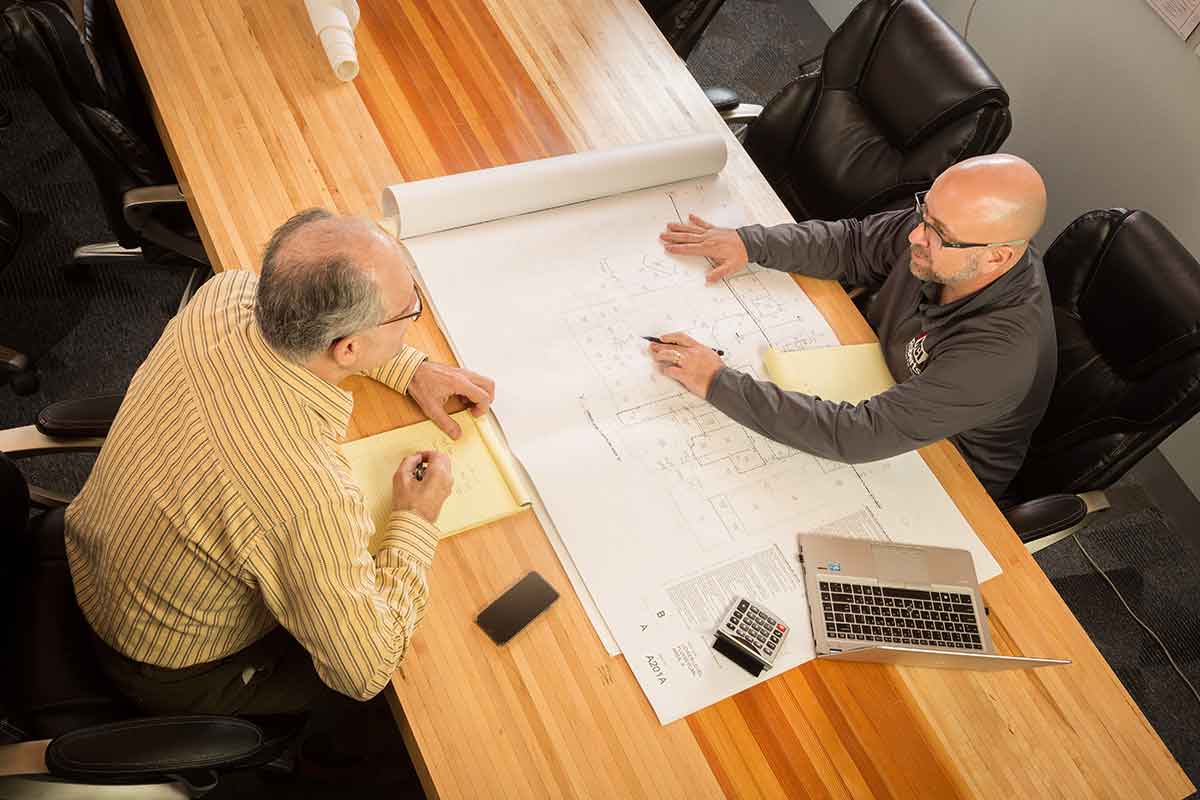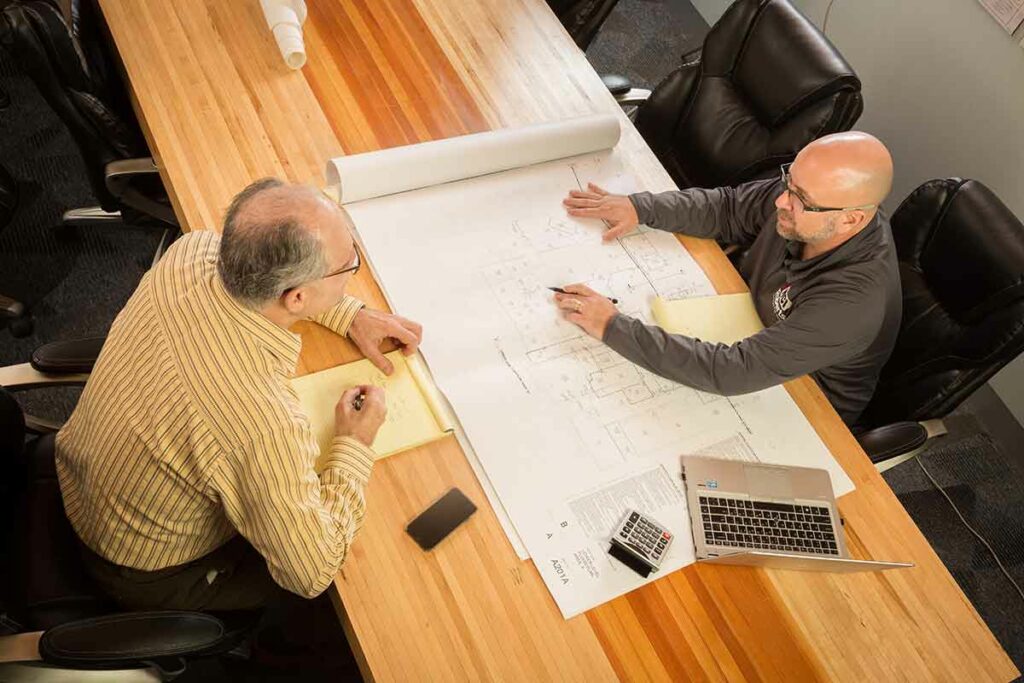Obtaining bids on your project plans from several general contractors may seem like the best way to get the most value for the lowest price. But is it really?
 In the traditional design-bid-build process, it’s typical for business owners to have plans drawn by architects and then solicit bids from multiple contractors. Keeping the costs low is important to most owners, but the motivations of the owner and the bidding contractors can be different, and the competitive bidding process contains potential pitfalls that can add unexpected expenses later. “Bidders want to be the low number,” says Bernie Lange, project development manager for National Construction. But because there can be so much uncertainty in the process, “if you ask three contractors for bids, the only guarantee is that you’ll get three numbers.”
In the traditional design-bid-build process, it’s typical for business owners to have plans drawn by architects and then solicit bids from multiple contractors. Keeping the costs low is important to most owners, but the motivations of the owner and the bidding contractors can be different, and the competitive bidding process contains potential pitfalls that can add unexpected expenses later. “Bidders want to be the low number,” says Bernie Lange, project development manager for National Construction. But because there can be so much uncertainty in the process, “if you ask three contractors for bids, the only guarantee is that you’ll get three numbers.”
National Construction has worked with a variety of trusted architectural partners on successful design-bid-build (also called bid-spec) projects, and if that is the direction for an owner’s project, we are happy to make a recommendation if needed, and submit our bid. But there are many reasons why having plans drawn up first and then bidding them out may not always be the most economical solution.
One pitfall: Building material prices fluctuate
An owner has a vision for their building project and has a budget in mind. In the bid-spec project delivery method, they hire an architect to draw plans that reflect their vision. Architects are experts in designing buildings to fit the space parameters, important interior adjacencies, local building codes, and many other technical aspects of building. However, architects may not be fully up-to-date on the cost of building materials, which have fluctuated rapidly post-pandemic. In addition, material prices can change between decision-making on the plans and when the owner finalizes an agreement with a general contractor.
“Drawing plans with no cost input can be problematic,” says Bernie. “The plans reflect the owner’s vision, and the owner is often emotionally invested in those plans. If it is determined after plans are completed that the cost is more than the owner has budgeted, the owner may struggle to revise the vision or budget, and additional fees for design revisions may apply. It can be painful financially and emotionally.”
How the design-build process avoids this: National Construction advocates for contractor-architect collaboration early on, knowing it will lead to the most efficient use of funds. The owner chooses one firm for both design and construction services; then the general contractor subcontracts the architect. This structure offers the owner less risk, and the process has more focus on the owner’s budget.
This method also incorporates experts who know the current cost of building materials into the design process so that they can offer alternatives. The design can course-correct as necessary as it evolves to ensure that the budget is maintained. A budget is provided during each phase of the design process, allowing the owner to understand how the elements of their vision impact the budget. Then the owner is able to prioritize how the available funds are used.
Another pitfall: The bid may not reflect the level of quality that the owner envisions
In a design-bid-build project, the architect’s plans may look just as the owner envisioned. “But not every fixture or finish might be indicated on the plans,” says Bernie. If the plans do not specify every detail, bidders will likely estimate on the low end of the quality scale in order to keep their bids lower, and therefore win the job. There is a wide range of quality available in flooring, fixtures, window coverings, and nearly every other aspect of a building.
Perhaps an owner envisioned everything being the lowest possible quality in their building, and therefore the cheapest price, but most business owners don’t. The low bid might have to be adjusted upward later to better reflect what the owner had in mind once they actually see what they’ll be getting.
How the design-build process avoids this: A design-build team can work with the owner to identify the level of quality they envision for the project, provide a more accurate cost to build to that level of quality, and suggest areas for cost savings based on the owner’s priorities.
A final pitfall: The project may take longer than expected
As described above, designing the project first and then bidding it out may necessitate later design changes, all of which will require additional time. “This can be a significant additional expense for owners, who want the project done ASAP in order to save interest costs on their loans,” Bernie explains. Another possible cost from delays comes from tenants, to whom the owner may need to pay a penalty if the project is not done on time. Low bidders might not be able to guarantee finishing on schedule.
How the design-build process avoids this: The design-build process removes uncertainty and is more efficient, allowing the project to progress at the right speed to control expenses and secure leases.
The design-build process works for owners and contractors alike
According to Fails Management Institute’s Design-Build Utilization Update from 2021, “Design-build was noted to enable greater team collaboration that resulted in a high-quality end-result. By involving key stakeholders early in the process, the design-build team is able to identify and better address the owner’s goals and objectives, ultimately leading to a more positive project experience for all involved.” In the study, over 50% of survey respondents indicated design-build exceeded expectations, and over 75% have had a “very good” or “excellent” experience on their design-build projects.
National Construction has the experience to meet business owners’ needs and finish projects on time and on budget
Regardless of the process you choose, we have the resources and experience to make your project a success.
Get in touch with us! You can connect with Bernie Lange on LinkedIn or via email.

